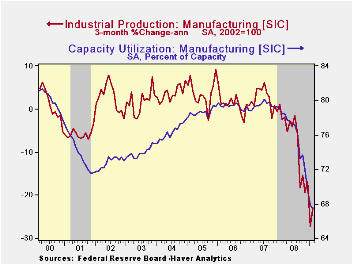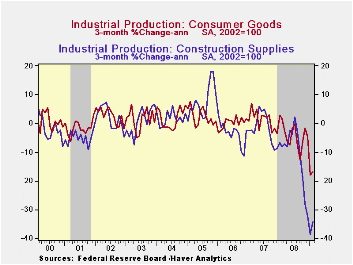 Global| Mar 16 2009
Global| Mar 16 2009Skid in U.S. Factory Output Is Sharpest Since 1975; Utilization Rate Reaches Record Low
by:Tom Moeller
|in:Economy in Brief
Summary
Declining demand coupled with cutbacks to inventory levels continue to severely depress U.S. factory sector activity. During February, industrial production fell 1.5% after the little-revised 1.9% drop during January. Last month's [...]

Declining demand coupled with cutbacks to inventory levels continue to severely depress U.S. factory sector activity. During February, industrial production fell 1.5% after the little-revised 1.9% drop during January. Last month's decline about matched Consensus expectations for a 1.3% decline.
Year-to-year output fell 12.2%, the sharpest decline since early 1975. The drop owes to reduced U.S. demand, inventory cutbacks and recessions abroad. These forces have combined to lower overall U.S. production to a degree that roughly matches earlier, severe recessions. Moreover, the decline is just short of the record set following World War II.
To make matters worse, the falloff has been picking up momentum. During the last three months, the rate of decline accelerated to 20.8% (AR). Factory sector output alone is off at a 22.9% annual rate during the last three months versus a full-year drop of 2.6%.
The downward trend in the output of motor vehicles & parts took a breather last month and production rose 10.2%. Nevertheless, output fell at a 66.3% annual rate during the last three months. Outside of the auto sector, output also was hard hit. It fell 1.7% during February and at an 18.0% rate during the last three months. The downturn in the housing market continues to cause stress. Output of construction supplies fell 2.2% last month and at a 34.1% annual rate during the last three. Output of consumer goods overall fell 0.7% last month and at a 17.0% rate since November. Production of furniture fell at a 25.0% rate during the last three months while apparel output fell at a 24.8% rate. Production of business equipment continued lower last month with a 1.3% decline and it fell at an 11.5% since November.
Pain has come to an area which previously was immune. Industrial production in the high-tech sector fell 3.4% last month and at a 32.1% rate during the last three. That follows a 16.0% increase during last year. Less high tech, overall industrial production fell 0.8% during February and the annual rate of change of -24.7% was the weakest since 1975.
Outside of the auto and high tech sectors, total factory production fell 1.1% last month and the three-month annual rate of decline accelerated further to -19.1%.
Excess capacity grew even further last month. Capacity utilization fell to 70.9%, the lowest level since 1982. Utilization in the factory sector dropped even harder to 67.4% from a peak near 80% back in 2007. The latest rate was a record low. Growth in the total productive capacity of the factory sector has slowed to 1.2% (y/y).
The industrial production data are available in Haver's USECON database.
The Credit Crunch of 2007-2008: A Discussion of the Background, Market Reactions and Policy Responses from the Federal Reserve Bank of St. Louis can be found here.
| INDUSTRIAL PRODUCTION (SA, %) | February | January | Y/Y | 2008 | 2007 | 2006 |
|---|---|---|---|---|---|---|
| Total Output | -1.5 | -1.9 | -11.2 | -1.8 | 1.7 | 2.2 |
| Manufacturing | -0.8 | -2.7 | -13.1 | -2.6 | 1.7 | 2.4 |
| Consumer Goods | -0.7 | -2.0 | -8.5 | -2.1 | 1.7 | 0.3 |
| Business Equipment | -1.3 | -4.3 | -11.8 | -1.2 | 3.3 | 10.4 |
| Construction Supplies | -2.2 | -4.1 | -18.2 | -6.2 | -2.5 | 2.2 |
| Utilities | -7.7 | 2.6 | -7.8 | 0.5 | 3.3 | -0.6 |
| Capacity Utilization | 70.9 | 71.9 | 80.7 (Feb.'08) | 78.2 | 81.0 | 80.9 |
Tom Moeller
AuthorMore in Author Profile »Prior to joining Haver Analytics in 2000, Mr. Moeller worked as the Economist at Chancellor Capital Management from 1985 to 1999. There, he developed comprehensive economic forecasts and interpreted economic data for equity and fixed income portfolio managers. Also at Chancellor, Mr. Moeller worked as an equity analyst and was responsible for researching and rating companies in the economically sensitive automobile and housing industries for investment in Chancellor’s equity portfolio. Prior to joining Chancellor, Mr. Moeller was an Economist at Citibank from 1979 to 1984. He also analyzed pricing behavior in the metals industry for the Council on Wage and Price Stability in Washington, D.C. In 1999, Mr. Moeller received the award for most accurate forecast from the Forecasters' Club of New York. From 1990 to 1992 he was President of the New York Association for Business Economists. Mr. Moeller earned an M.B.A. in Finance from Fordham University, where he graduated in 1987. He holds a Bachelor of Arts in Economics from George Washington University.






